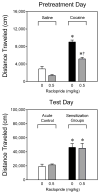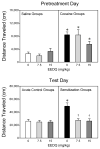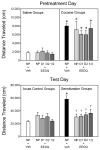Importance of D1 and D2 receptor stimulation for the induction and expression of cocaine-induced behavioral sensitization in preweanling rats
- PMID: 28284952
- PMCID: PMC5422209
- DOI: 10.1016/j.bbr.2017.03.001
Importance of D1 and D2 receptor stimulation for the induction and expression of cocaine-induced behavioral sensitization in preweanling rats
Abstract
The behavioral manifestations of psychostimulant-induced sensitization vary markedly between young and adult rats, suggesting that the neural mechanisms mediating this phenomenon differ across ontogeny. In this project we examined the importance of D1 and D2 receptors for the induction and expression of cocaine-induced behavioral sensitization during the preweanling period. In the behavioral experiments, rats were injected with reversible D1 and/or D2 antagonists (SCH23390 and/or raclopride) or an irreversible receptor antagonist (EEDQ) either before cocaine administration on the pretreatment day (induction) or before cocaine challenge on the test day (expression). In the EEDQ experiments, receptor specificity was assessed by using selective dopamine antagonists to protect D1 and/or D2 receptors from inactivation. Receptor binding assays showed that EEDQ caused substantial reductions in dorsal striatal D1 and D2 binding sites, while SCH23390 and raclopride fully protected D1 and D2 receptors from EEDQ-induced alkylation. Behavioral results showed that neither D1 nor D2 receptor stimulation was necessary for the induction of cocaine sensitization in preweanling rats. EEDQ disrupted the sensitization process, suggesting that another receptor type sensitive to EEDQ alkylation was necessary for the induction process. Expression of the sensitized response was prevented by an acute injection of a D1 receptor antagonist. The pattern of DA antagonist-induced effects described for preweanling rats is, with few exceptions, similar to what is observed when the same drugs are administered to adult rats. Thus, it appears that maturational changes in D1 and D2 receptor systems are not responsible for ontogenetic differences in the behavioral manifestation of cocaine sensitization.
Keywords: Behavioral sensitization; Cocaine; EEDQ; Ontogeny; Raclopride; SCH23390.
Copyright © 2017 Elsevier B.V. All rights reserved.
Figures








Similar articles
-
Effects of D2 or combined D1/D2 receptor antagonism on the methamphetamine-induced one-trial and multi-trial behavioral sensitization of preweanling rats.Psychopharmacology (Berl). 2016 Mar;233(5):893-903. doi: 10.1007/s00213-015-4170-0. Epub 2015 Dec 9. Psychopharmacology (Berl). 2016. PMID: 26650612 Free PMC article.
-
Day/night differences in D1 but not D2 DA receptor protection from EEDQ denaturation in rats treated with continuous cocaine.Synapse. 1993 Jan;13(1):20-9. doi: 10.1002/syn.890130104. Synapse. 1993. PMID: 8093985
-
Age-dependent differences in the rate of recovery of striatal dopamine D1 and D2 receptors after inactivation with EEDQ.Eur J Pharmacol. 1994 Feb 3;252(2):225-31. doi: 10.1016/0014-2999(94)90601-7. Eur J Pharmacol. 1994. PMID: 8157063
-
Behavioral sensitization and tolerance to cocaine and the occupation of dopamine receptors by dopamine.Mol Neurobiol. 1995 Aug-Dec;11(1-3):31-46. doi: 10.1007/BF02740682. Mol Neurobiol. 1995. PMID: 8561966 Review.
-
Role of D1 and D2 dopamine receptors in the behavioral effects of cocaine.Neurochem Int. 1992 Mar;20 Suppl:147S-152S. doi: 10.1016/0197-0186(92)90228-j. Neurochem Int. 1992. PMID: 1365414 Review. No abstract available.
Cited by
-
Distinctive Neuroanatomic Regions Involved in Cocaine-Induced Behavioral Sensitization in Mice.Biomedicines. 2023 Jan 27;11(2):383. doi: 10.3390/biomedicines11020383. Biomedicines. 2023. PMID: 36830920 Free PMC article.
-
Chronic early-life lead exposure sensitizes adolescent rats to cocaine: Role of the dopaminergic system.Front Mol Neurosci. 2022 Aug 24;15:946726. doi: 10.3389/fnmol.2022.946726. eCollection 2022. Front Mol Neurosci. 2022. PMID: 36090247 Free PMC article.
-
Effects of the monoamine stabilizer, (-)-OSU6162, on cocaine-induced locomotion and conditioned place preference in mice.Naunyn Schmiedebergs Arch Pharmacol. 2021 Jun;394(6):1143-1152. doi: 10.1007/s00210-021-02053-x. Epub 2021 Jan 20. Naunyn Schmiedebergs Arch Pharmacol. 2021. PMID: 33471153
References
-
- Substance Abuse and Mental Health Services Administration. Behavioral Health Trends in the United States: Results from the 2014 National Survey on Drug Use and Health. SAMSHA; Rockville, MD: 2015.
-
- Johnston LD, O’Malley PM, Miech RA, Bachman JG, Schulenberg JE. Monitoring the Future National Survey Results on Drug Use: 1975–2014: Overview, Key Findings on Adolescent Drug Use. The University of Michigan; Ann Arbor, MI: 2015.
-
- Substance Abuse and Mental Health Services Administration. The TEDS Report: Age of Substance Use Initiation Among Treatment Admissions Aged 18 to 30. SAMSHA; Rockville, MD: 2014. - PubMed
-
- Lopez-Quintero C, Pérez de los Cobos J, Hasin DS, Okuda M, Wang S, Grant BF, Blanco C. Probability and predictors of transition from first use to dependence on nicotine, alcohol, cannabis, and cocaine: results of the National Epidemiologic Survey on Alcohol and Related Conditions (NESARC) Drug Alcohol Depend. 2011;115:120–130. - PMC - PubMed
Publication types
MeSH terms
Substances
Grants and funding
LinkOut - more resources
Full Text Sources
Other Literature Sources

